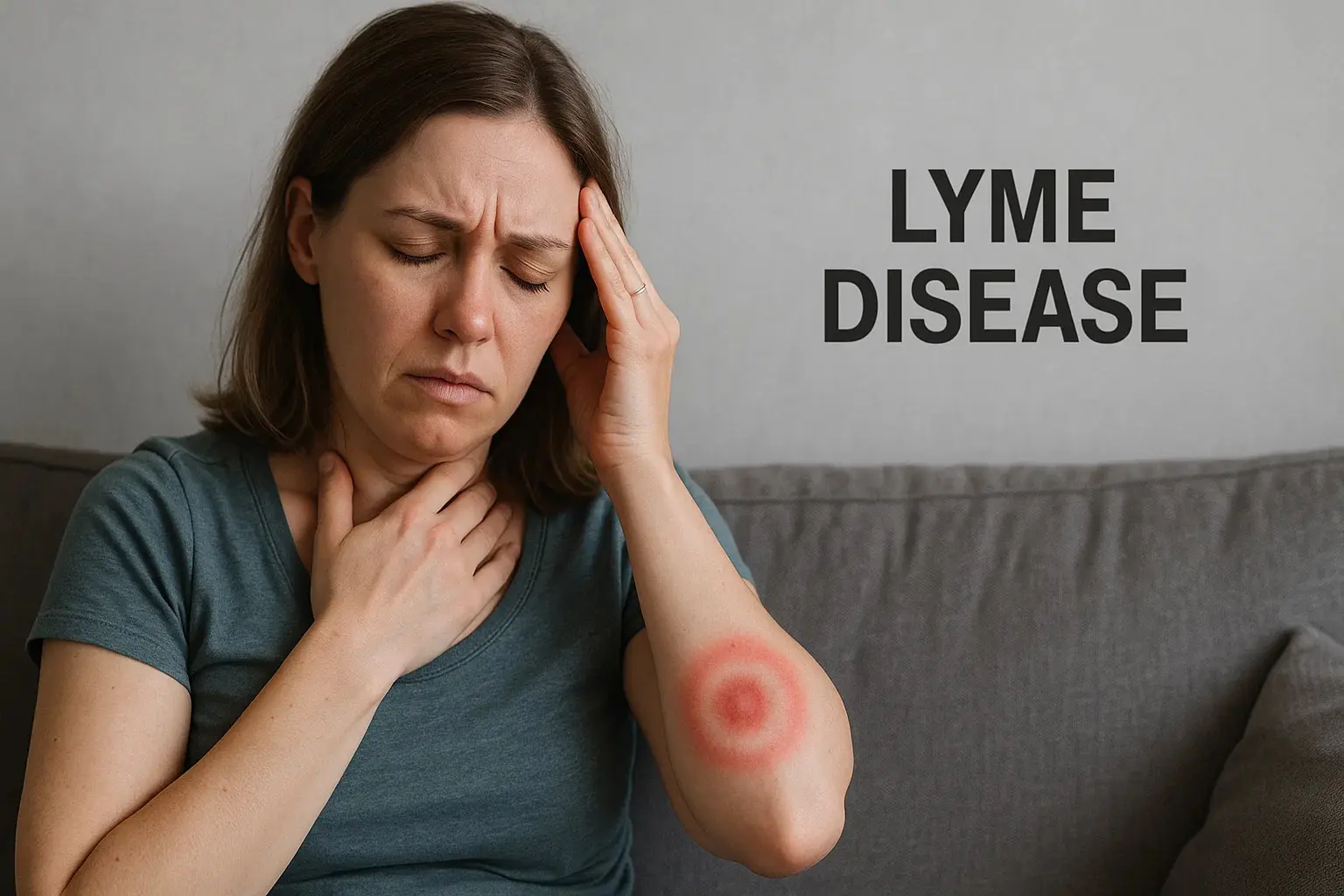Effective Lyme disease treatment combines timely antibiotic therapy with integrative approaches like EBOO ozone therapy and supportive modalities to reduce inflammation, boost immunity, and promote overall healing tailored to each individual’s needs.
If you or a loved one is searching for the best treatment for Lyme disease in humans, you are not alone. Lyme disease is a complex infection that affects thousands of people every year, caused by the bacterium Borrelia burgdorferi, transmitted primarily through the bite of infected black-legged ticks. Understanding how Lyme disease develops, its symptoms, and the most effective treatments available can empower you to take the right steps for your health.
This article explores all you need to know about Lyme disease — from symptoms to treatments, including antibiotics, integrative therapies, and prevention strategies. We’ll also address some common questions like “Can Lyme disease kill you?”, “Is Lyme disease contagious?”, and “Is Lyme disease a problem in Texas?”
Understanding Lyme Disease
Lyme disease begins with the bite of an infected tick. The bacterium enters the bloodstream and can spread throughout the body. Early symptoms often include:
- A red, expanding rash (often a “bull’s-eye” rash called erythema migrans)
- Fever and chills
- Fatigue
- Muscle and joint aches
- Headaches
As the disease progresses, symptoms can become more severe and affect different organ systems, leading to neurological problems, arthritis, heart issues, and cognitive difficulties.
Lyme Disease Symptoms: What to Watch For
Early recognition of symptoms is key for effective treatment. Symptoms can vary widely, but the most common include:
- Erythema migrans rash: Occurs in about 70-80% of infected people; usually appears 3-30 days after tick bite
- Flu-like symptoms: Fever, chills, headache, fatigue, muscle and joint aches
- Joint pain and swelling: Often affecting knees or other large joints
- Neurological symptoms: Facial palsy (loss of muscle tone or droop on one or both sides of the face), numbness, tingling, memory issues
- Heart palpitations or irregular heartbeat (Lyme carditis)
Top 3 Severe Symptoms of Lyme Disease
If untreated, Lyme disease can cause severe complications such as:
- Lyme arthritis: Persistent joint swelling and pain
- Neurological Lyme disease: Problems like meningitis, neuropathy, or encephalopathy
- Lyme carditis: Affecting heart rhythm and function
Is Lyme Disease a Problem in Texas?
While Lyme disease is more common in the Northeastern and upper Midwestern United States, it is present in Texas as well. Texas has documented cases of Lyme disease, especially in wooded and rural areas where ticks thrive. The risk may be lower compared to endemic regions but remains a concern for outdoor enthusiasts, farmers, and those exposed to tick habitats.
How to Prevent Lyme Disease
Prevention is crucial since early treatment leads to better outcomes. Effective strategies include:
- Avoiding tick-infested areas, especially during peak tick season (spring and summer)
- Wearing long sleeves and pants, and using insect repellents containing DEET
- Performing thorough tick checks after outdoor activities
- Removing ticks promptly and correctly with tweezers
- Keeping lawns and outdoor spaces tick-free by trimming vegetation
What is the Most Effective Treatment for Lyme Disease?
The treatment for Lyme disease in humans depends largely on the stage of infection and symptom severity. Early-stage Lyme disease is generally treated effectively with antibiotics. Treatment aims to kill the Borrelia bacteria before it spreads widely and causes complications.
Antibiotics for Lyme Disease in Adults
The Centers for Disease Control and Prevention (CDC) and Infectious Disease Society of America (IDSA) recommend several antibiotics for treating Lyme disease, including:
- Doxycycline: The most commonly prescribed antibiotic for adults and children over 8 years old
- Amoxicillin: An alternative for pregnant women, young children, or those who cannot tolerate doxycycline
- Cefuroxime axetil: Another alternative if doxycycline or amoxicillin cannot be used
Lyme Disease Treatment Doxycycline Dose
For early Lyme disease, doxycycline is typically prescribed as:
- 100 mg twice daily for 10 to 21 days
For some neurological or cardiac Lyme complications, intravenous antibiotics like ceftriaxone may be recommended.
How Many Days of Doxycycline for Tick Bite?
If you are bitten by a tick and meet certain criteria, a single dose of doxycycline (200 mg) may be given within 72 hours to reduce the risk of developing Lyme disease. However, this is not a treatment for established infection but a preventive measure.
For confirmed Lyme disease, the full course of 10-21 days is needed.
How Long Does It Take to Feel Better After Starting Antibiotics for Lyme Disease?
Most people start to feel better within a few days to a few weeks after beginning antibiotic treatment. Fatigue and other symptoms may persist for some time but usually improve gradually.
Some patients experience Post-Treatment Lyme Disease Syndrome (PTLDS) where symptoms persist despite appropriate antibiotic therapy. The reasons for PTLDS are not fully understood and are the subject of ongoing research.
Is Lyme Disease 100% Curable?
Early Lyme disease treated promptly with antibiotics has a very high cure rate. Most patients recover fully without long-term effects. However, some may experience lingering symptoms despite treatment, which can be frustrating.
Late-stage or chronic Lyme disease can be more difficult to treat, requiring longer or more comprehensive approaches.
Late Stage Lyme Disease Treatment
Late-stage Lyme disease may require:
- Longer courses of antibiotics, sometimes intravenous
- Symptom management including pain relief and anti-inflammatory medications
- Supportive therapies to improve immune function and reduce inflammation
An integrative approach can be particularly helpful here to address the complex symptoms and support recovery.
Can Lyme Disease Kill You?
Lyme disease is rarely fatal if treated appropriately. However, serious complications like Lyme carditis (heart inflammation) can cause life-threatening problems if untreated.
Early detection and treatment are critical to preventing severe outcomes.
Lyme Disease Life Expectancy
Lyme disease itself does not typically affect life expectancy when treated properly. However, untreated or late-stage Lyme disease complications may impact quality of life and health.
Is Lyme Disease Contagious?
Lyme disease is not contagious from person to person. It is transmitted only through the bite of infected ticks. You cannot catch Lyme disease from another person through casual contact, sexual transmission, or airborne routes.
Is Lyme Disease Permanent?
Lyme disease is generally not permanent if treated properly. However, some individuals may have prolonged symptoms or develop autoimmune responses triggered by the infection, which may require ongoing management.
What Happens If Lyme Is Not Treated?
Untreated Lyme disease can lead to serious complications including:
- Chronic arthritis
- Neurological problems such as meningitis or neuropathy
- Heart problems including irregular heartbeat
- Cognitive difficulties
Delays in treatment increase the risk of these complications.
Integrative Treatments at Wellness Revolution Texas
Alongside conventional antibiotic treatment, integrative therapies can support the body’s healing processes, especially for lingering symptoms.
EBOO (Extracorporeal Blood Oxygenation and Ozonation)
EBOO is an advanced ozone therapy where blood is treated outside the body with oxygen and ozone, then returned. This therapy aims to:
- Improve oxygen delivery to tissues
- Support immune modulation
- Aid detoxification
- Reduce inflammation
Though more research is needed, ozone therapy is widely used in integrative medicine to support patients with chronic infections and inflammation.
Red Light Therapy, Whole Body Cryotherapy, Infrared Sauna
Adding therapies like:
- Red light therapy: Helps reduce inflammation and promote tissue repair
- Whole body cryotherapy: Can reduce systemic inflammation and pain
- Infrared sauna: Supports detoxification and circulation
can further help manage symptoms and improve quality of life.
Personalized Wellness Assessments
At Wellness Revolution Texas, every treatment plan begins with a thorough assessment. This helps identify your unique needs and tailors therapies that best support your healing alongside your conventional medical care.
Upcoming Free Health & Wellness Assessments
We offer FREE assessments at:
- Katy Location: May 29th
- Memorial Location: May 30th and 31st
Meet with our experts, including Jason DeLeon, one of only three EBOO specialists in the country, to discuss your condition and explore treatment options.
Fill this form to book your spot and get 50% off your first treatment
Locations & Contact
Katy Location:
9727 Spring Green Blvd Suite 150, Katy, TX 77494
Phone: (281) 853-9347
Memorial Location:
12526 Memorial Dr, Houston, TX 77024
Phone: (281) 853-9347
Conclusion
If you are navigating Lyme disease, understanding your treatment options is vital. Antibiotics remain the foundation of treatment for Lyme disease in humans, especially early on. Integrative therapies like EBOO ozone therapy and supportive modalities may complement conventional care to help manage symptoms and support healing.
Always consult your healthcare provider before starting any new treatment. Early diagnosis and comprehensive care can make all the difference in your recovery and quality of life.





